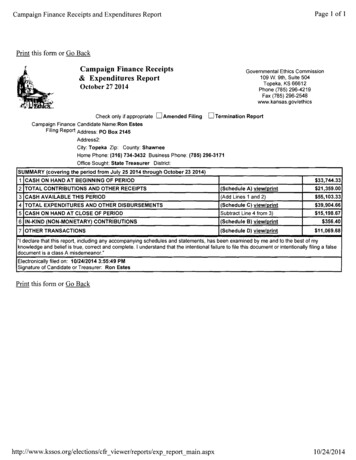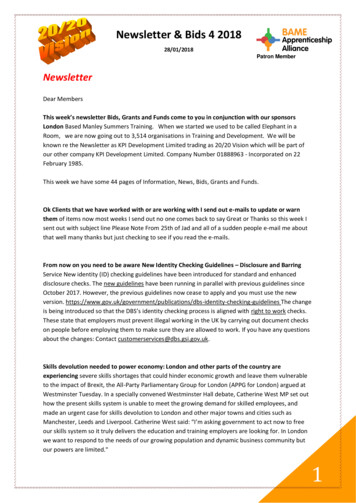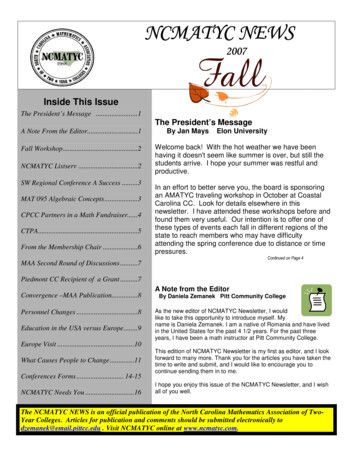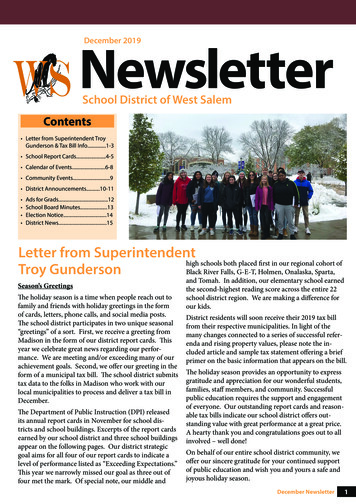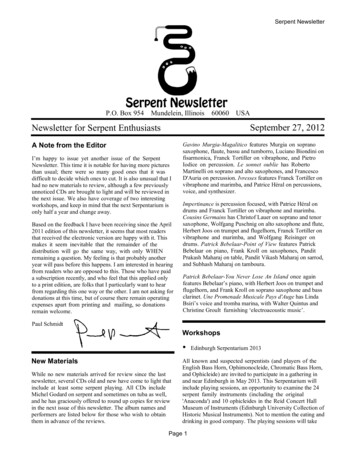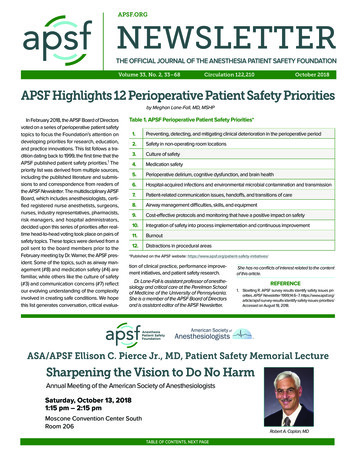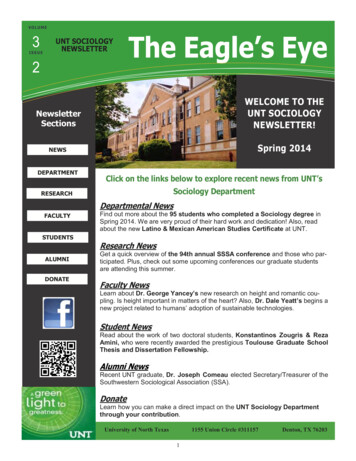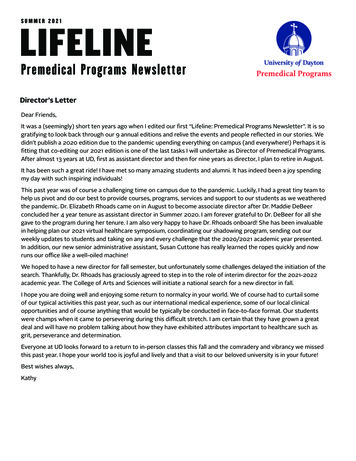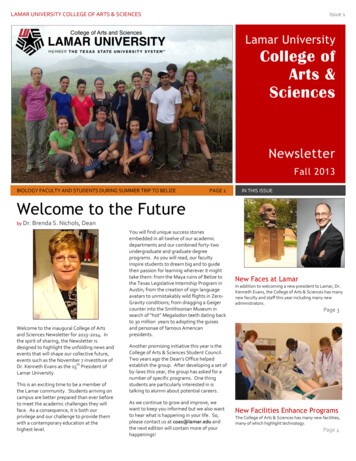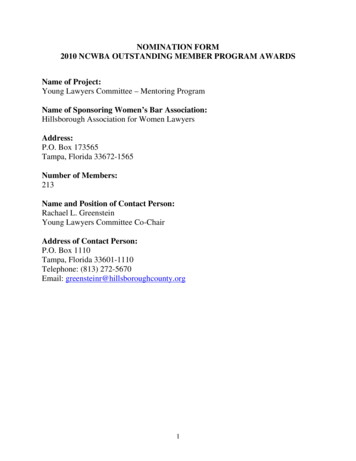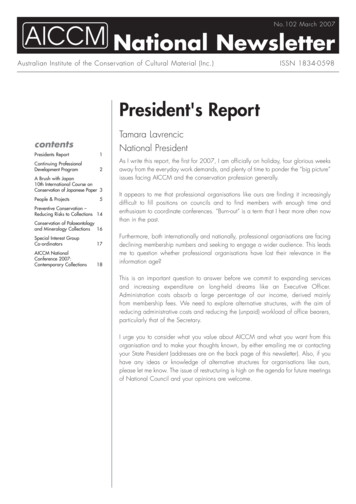
Transcription
No.102 March 2007National NewsletterAustralian Institute of the Conservation of Cultural Material (Inc.)ISSN 1834-0598President's ReportTamara LavrenciccontentsPresidents Report1Continuing ProfessionalDevelopment Program2A Brush with Japan10th International Course onConservation of Japanese Paper 3People & Projects5Preventive Conservation –Reducing Risks to Collections 14Conservation of Palaeontologyand Mineralogy Collections 16Special Interest GroupCo-ordinators17AICCM NationalConference 2007:Contemporary Collections18National PresidentAs I write this report, the first for 2007, I am officially on holiday, four glorious weeksaway from the everyday work demands, and plenty of time to ponder the “big picture”issues facing AICCM and the conservation profession generally.It appears to me that professional organisations like ours are finding it increasinglydifficult to fill positions on councils and to find members with enough time andenthusiasm to coordinate conferences. “Burn-out” is a term that I hear more often nowthan in the past.Furthermore, both internationally and nationally, professional organisations are facingdeclining membership numbers and seeking to engage a wider audience. This leadsme to question whether professional organisations have lost their relevance in theinformation age?This is an important question to answer before we commit to expanding servicesand increasing expenditure on long-held dreams like an Executive Officer.Administration costs absorb a large percentage of our income, derived mainlyfrom membership fees. We need to explore alternative structures, with the aim ofreducing administrative costs and reducing the (unpaid) workload of office bearers,particularly that of the Secretary.I urge you to consider what you value about AICCM and what you want from thisorganisation and to make your thoughts known, by either emailing me or contactingyour State President (addresses are on the back page of this newsletter). Also, if youhave any ideas or knowledge of alternative structures for organisations like ours,please let me know. The issue of restructuring is high on the agenda for future meetingsof National Council and your opinions are welcome.contents
Apology toSecretariat AustraliaThe AGM Minutes printed inthe AICCM Newsletter 101,December 2006, made anumber of statements aboutSecretariat Australia.It has been pointed out to usthat the article might have beeninterpreted as suggesting thatthe performance of SecretariatAustralia had not been adequate.We did not intend to convey anysuch suggestion. If the article didgive rise to such a suggestion itwas completely without foundation.We greatly regret any distress orembarrassment that the statementin the AGM Minutes may havecaused to Secretariat Australia,and insofar as it might haveconveyed any such suggestion,we apologise to SecretariatAustralia and withdraw thatsuggestion unreservedly.Tamara Lavrencic onbehalf of NationalCouncil, AICCM Inc.CCMC to deliverProfessionalDevelopment ProgramJulian BickerstethOn behalf of the Education Standing CommitteeAs announced by our President, Tamara Lavrencic at the AGM inSydney last November, AICCM has reached agreement with theCentre for Cultural Materials Conservation (CCMC) at The Universityof Melbourne to coordinate and deliver the Institute’s ContinuingProfessional Development Program (CPDP). CPD is rapidly becominga recognised requirement in most professions. It is generally describedas the means by which members of professional associations maintain,improve and broaden their knowledge and skills and develop thepersonal qualities required in their professional lives.New developments and trends in conservation, growing expectationsof clients and stakeholders, and the increasingly complexorganisational requirements of conservators highlight the imperativefor continuing professional development to take place both withinthe workplace and via external delivery. Emphasising the need for,and the benefits of, CPD is a key role of professional organisations,and AICCM, especially through the activity of the SIGs, has a proudtrack record of achievement in this regard.A key consideration in the decision to work with CCMC is the needfor a sustainable program, both financially and in relation to marketrequirements. For this to be achieved a coordinated calendar of eventsneeds to be scheduled that aligns National, State and SIG events,along with other related activities such as, specialised workshops andgraduate research conferences. It is hoped that efficiencies that canbe gained through programming alignment will result in increasedattendance at each event and likely reduced attendance costs.CCMC has the advantage of access to quality teaching spaces andan administrative framework that is familiar with relevant processes(publicity and promotion, registration, invoicing etc).AICCM, through the Education Standing Committee, will workwith the CCMC to identify and prioritise training needs. We willbe asking SIG Convenors to discuss ideas for future workshops,conferences, and symposia, and invite all members to contacttheir SIG Convenors with ideas for these. SIG convenors will workwith the Standing Committee and CCMC to establish an ongoing,coordinated professional development calendar.We are pleased to be working with the CCMC on this importantinitiative, and thank Robyn Sloggett and Marcelle Scott for theirenthusiasm and professionalism.AICCM National Newsletter No 102 March 2007
A Brush with Japan10th International Course onConservation of Japanese PaperFiona KempNational Gallery of AustraliaIn September 2006, ten conservation-related professionalsgathered in Tokyo for the ICCROM International Course onConservation of Japanese Paper. The countries representedwere Argentina, Australia, France, Italy, Greece, TheNetherlands, Iran, USA, Korea and Denmark. The JapaneseGovernment sponsored participants to attend the three weekcourse which was presented in English, and hosted by theNational Research Institute for Cultural Properties, Tokyo(NRICPT). The course was based on a series of lectures andpractical sessions in the first and third weeks, while a studytour to Mino and Kyoto occupied the second week.The course was established with the aim of providing trainingfor foreign conservators working on collections with Japanesepaper based objects such as folding screens, sliding doors,hanging scrolls and hand scrolls. These objects are structurallycomplex, commonly susceptible to damage because of theneed to be folded or rolled and are vulnerable to climaticchange. The Japanese have been restoring paper artefactssuccessfully using techniques which have remained unchangedfor centuries. The materials and tools are still traditional andthe specialised craft of papermaking is crucial to restoration.Our practical lecturers were senior restorers based mostly inKyoto, while the theory lecturers consisted of a combinationof Government officials, art historians, scientists, andrestorers. During the three weeks, each participant madea hand scroll. In making the hand scroll, the honshi tobe mounted was cleaned, patched, lined with paper,stretched and assembled. Techniques included preparingand applying adhesives and using various Japanese papersin restoration. Traditional brushes, knives and spatulas werestudied and used to prepare materials.Washi is the traditional craft of handmade paper in Japan.Kozo or Paper Mulberry bark is the major papermakingfibre used to make washi. The kozo is harvested annuallyin the winter; the bark is stripped, cooked, cleaned andbeaten before making a pulp solution. The papermakerforms a sheet by dipping the mould or sugeta into the pulpsolution several times, agitating between dipping. Theresulting paper is thin yet strong – a quality achieved by thelong and entwined paper fibres.Mr Hasegawa checks the paper mould after forming the sheet(Hasegawa Washi Kobo workshop, Mino)During the second week of the course we visitedMr Hasegawa of Hasegawa Washi Kobo, who specialisesin making restoration papers and supplies major restorationstudios in Japan. His studio is located in a mountainousarea near Mino in Gifu prefecture. Mino is renownedfor producing minogami – made from kozo fibre and isconsidered some of the finest quality Japanese papers.The fast flowing river that weaves its way through the areawas highly populated with ambitious fisherman in theirwaders. In days gone by, the river was once essential to thepapermaking process for the cleaning of the bark fibre.Mrs Hasegawa cleans impurities from the kozo bark in cleanrunning water (Hasegawa Washi Kobo workshop, Mino)After our visit to Mino, our study trip took us to Kyoto,where we visited several small traditional restorationstudios, OKA Bokkodo Co. Ltd. and KOEIDO Co. Ltd.,where, of particular note, papers were made accordingAICCM National Newsletter No 102 March 2007
A Brush with Japanto the weight, structure and colour of the paper artefactthat they were restoring. OKA Bokkodo was incorporatinga modified leaf casting machine in their restorationwork. Our last day in Kyoto was spent visiting the KyotoNational Museum conservation studios. We were luckyenough to see a number of National Treasures undergoingrestoration, including exquisite paintings from templesliding doors and a series of very early hand scrolls whichhad been marked as a 15 year restoration project whichhad one dedicated restorer!Throughout the course, participants were able to experienceJapanese culture as well as attending lectures and doingpractical work, allowing a rounded experience. TheJapanese concept of wabi-sabi, although initially confusingto the uninitiated, relates to the ideology in Japanese culturethat concerns harmony, aestheticism and simplicity. Beautyis found in the imperfect, impermanent and incomplete andcan have implications for restoration. An example mightbe a hanging scroll that has been used as part of teaceremony. In this case, value is placed on evidence of theoriginal use of the scroll and it may be inappropriate torestore by replacing linings or removing stains.Mori-san and Sawada-san teach the specifics of makinga good wheat starch pasteThroughout the course we were shown many specialisttools, materials, adhesives and their preparation. Oneof particular interest was furunori or aged wheat starchcommonly used in the re-lining of scrolls. Fresh wheat starchpaste or shinnori is sealed into a large lidded earthenwarepot with water and stored for 10 years, usually under thefloor of a Japanese wooden house where it is cool andventilated. A thick skin of mould grows on the surface and,depending on which restoration studio has prepared it, thejar may be unsealed yearly for mould to be removed andwater changed. Aged paste is silky and smooth and smellslike a fine French cheese. The furunori is a weak adhesivewhich remains flexible, an important quality needed forthose Japanese works on paper that require rolling.The brush shop in KyotoMy short month in Japan allowed me to experience somewonderfully memorable moments. Heading back to my Kyotoryokan late one evening, having meandered through thenearby temple grounds from renowned Gion, I participatedin a spontaneous woodblock printing session in a smallprivate gallery/studio. Also in Kyoto was the ‘brush man’.His shop smelt strongly of mothballs, tatami covered the floorand the walls were lined with a treasure trove of boxes full ofhis handmade, finely-crafted brushes. These specialist brushesare large, have a wide wooden handle and bristles of eitherplant fibre or animal hair; they are primarily used for pastingand lining work in restoration studios. Our good businessand being foreigners earned us a refreshment of iced greentea and red bean paste sweets. The Japanese are mastersof presentation and packaging and my box of brushes waswrapped and tied in a carefully selected pink furoshiki.AICCM National Newsletter No 102 March 2007In the studio, Mori-san demonstrates pasting out paper for liningInitially it is difficult not to be overwhelmed by a city likeTokyo. I enjoyed getting lost amongst the neon, discoveringtemples and walking in the parks, where the gingko andmaple trees were abundant, greatly treasured and just aboutto take on their autumn colours. It is a vast culturally rich citythat presents many fascinating contrasts. My departure fromTokyo coincided with the arrival of another typhoon. Like aHiroshige woodblock print depicting figures battling withumbrellas against sheeting rain, I struggled across UenoPark in the wild wet weather to make one last visit to viewthe magnificent collection of the Tokyo National Museum.
A Brush with Japan EXPRESSIONS OF INTERESTThe National Gallery of Australia, Paper Conservators wouldlike to host a 3 day workshop in Japanese conservationtechniques for works of art on paper. The course will drawon experience gained in recent workshops attended in theUK and Japan. Sessions will be based around practical andtheoretical work. Dates are yet to be arranged, but mid-Juneor late November are possible dates. A fee of 210.00will be charged to cover costs. Please contact: Fiona Kemp Fiona.Kemp@nga.gov.au or ring the Paper ConservationLab on 02 6240 6470.Course participants and NRICPT staff outside the Kyoto National MuseumPeople & ProjectsACTAustralian MuseumThe Collections Integrity Unit is battening down the hatchesin preparation for the impact of the building works that willbe carried out this year. In February a number of changeswill take place in the laboratories, with the windows beingbricked up and the wiring replaced, as well as new frontand back doors. Staff are consequently working in a numberof other areas of the museum while this takes place. TashaBrown is working on an improved method of storagefor the Aboriginal spear collection. Michael Kelly andKatrina McCormick are working on the dismantlingof our Biodiversity and Kid’s Island galleries, which will betransformed into a Dinosaur Gallery in 2008. Michael Kellytraveled to St Louis Art Museum to pack our New Irelandcarvings prior to their transfer to the new anthropologymuseum in Paris for the second leg of the tour.Sarah McHugh has been trialling a new style ofenvironmental sensor that transmits data by radio frequenciesto a remote hub linked to the central environmentalmonitoring system. If satisfactory, it will be used to extendour monitoring system into more galleries and the newScience and Collections Building. Kate Jones is startingto assess our recently acquired Conservation Module forthe EMu collections database. The layout owes much to thepioneering work and experiences of the NGA and MuseumVictoria with their EMu conservation modules.Susie Collis was working on the update of the Disaster Planand the relocation of large Anthropology objects before sheleft us for a contract at the Queensland Art Gallery. Isa Loo,from the University of Melbourne conservation course, workedwith us for 3 weeks in January/February on the reconstructionof a Lapita pot excavated in Vanuatu last July.Colin Macgregor and Katrina McCormick, taxidermypreparator, attended the Natural Science Workshop held atthe Melbourne Museum in December and came away withmuch useful information and numerous good ideas. SeeColin’s review in this Newsletter.The proposal to integrate the Australian Museum and thePowerhouse Museum has been put on hold until after theoutcome of the State Election in March. A considerableamount of correspondence has been received by theState Government in support of maintaining the level ofservices at the two museums and The Minister for the Artsacknowledged a letter sent by the National President ofAICCM expressing concern about the possible impact onconservation at the institutions.Australian War MemorialConservation has started in earnest on the new Post 1945Galleries. Textile lab staff are treating textiles for thesegalleries and Eileen Proctor has almost finished surveyingsmall objects destined for the galleries. Conservation of theHMAS Brisbane relics, including the radar equipment roomand gun director, continues. In situ conservation on the gunturret has just commenced, and work on the bridge hasbeen finalised. Conservation on the Meteor nose and theUNTAG Land Rover is complete.In the objects lab, Megan Jordon-Jones has beencleaning and repairing a POW doll house. The maker wasa baker and the style of the two-story construction reflectsthis, fortunately though, it’s not made of gingerbread.George Bailey has been working on loan items, a Lewisgun in particular. The LTO team is scoping treatments for theWWI aeroplanes.AICCM National Newsletter No 102 March 2007
The textile lab has packed the bomb damaged Darwin Flag forloan to the Museum and Art Gallery of the Northern Territory.Kerry McInnis is back working in the paper lab one daya week. As for Gajendra Rawat, Bernard Kerteszand Sophie Lewincamp, its business as usual: exhibition,exhibition, remedial, and some more exhibition work!In the painted surfaces lab work on the Lambert exhibitionand loan continues. David Keany is presently making acouple of new frames to match the originals. He has alsobeen consolidating a terracotta sculpture in preparation forcasting. Ilaria Poli has treated a painting, which hadbeen removed from its stretcher and folded over a board.The painting required flattening, some consolidation and inpainting. It has now been strip lined and properly stretchedon a stretcher. Sharon Alcock has been solving theproblem of framing double-sided paintings on wood panelto enable visibility of the verso for future reference withoutchanging the depth or appearance of the frame.Currently the AWM, Treloar Centre for ConservationScience is abuzz with excitement about the upcomingHorse’s Doovers Cook Off. People who have had theprivilege of working with conservators already understandthe glory of their cooking expertise.National Library of AustraliaThere have been some dramatic changes in the arrangementsfor managing preservation services, due mainly to a seriesof restructures in the second half of 2006. Firstly, the SoundPreservation and Technical Services (SPATS) section wasamalgamated with the Oral History Branch. Their primaryclient within the library, Kevin Bradley, has becomethe new director of the Oral History branch and ShellyGrant remains the manager of SPATS. Secondly, thepreservation of digital collections was separated from thepreservation of the physical collections. Jennifer Lloydremains in charge of Collections Preservation and is themain point of contact regarding the care and preservationof the Library’s extensive collections of books, journals,pictures, manuscripts, maps, etc. Reformatting and theAustralian Newspaper Plan (ANPLAN) also continueunder Jennifer’s direction. Colin Webb now heads anew branch – Web Archiving and Digital Preservation(WADiP) which is responsible for collecting and controllingonline Australian publications, the preservation of alldigital collections, preservation standards and preservationpromotion in SE Asia and the Pacific. Some priorities forthe new branch include: reviewing the Library’s collectingapproaches; designing detailed workflows for managingpreservation of digital collections; developing standardsand tools to facilitate digital preservation in conjunctionwith Australian universities within the Australian Partnershipfor Sustainable Repositories and developing a digitisationtraining course for use in SE Asia and the Pacific.AICCM National Newsletter No 102 March 2007People & ProjectsOther staff changes during 2006 saw Rachel Spano departon maternity leave and Rowena Jameson become, again,the Exhibitions conservator. Jess Wignell, from the NationalArchives, will be working at the library for five months whilstRachel is away. Susanne Wullen was promoted duringthe year and continues to work in the laboratory with LydiaPreiss and Chesley Engram with Kerry McInnis,working one day a week on high priority collections. LisaJeong-Reuss acted as Manager of Treatment Programswhile Chesley Engram took three months leave beforeChristmas. We are looking forward to the arrival of Ching-HuiHuang, an intern from Taiwan, who will spend six months atthe Library, in order to complete her degree in Conservation.A major ongoing activity for 2006-2007 was the NationalTreasures from Australia’s Great Libraries travelling exhibition. Itopened at the Library in December 2005 and has since been toMelbourne, Hobart, Sydney and Brisbane. Both Rachel Spanoand Rowena Jameson have been part of the installation at eachvenue. It will visit the remaining capital cities during 2007.Our bookbinder-in-training, David Roberts, has finishedthe first two years of his apprenticeship by successfullycompleting all modules towards a certificate with NSWTAFE. He is being supervised and assessed by contractbinder, Neale Wootton.Susanne Wullen has been treating a new acquisition bythe Maps section – an 1831 German inflatable paperglobe by Philip Cella. Once able to be inflated to a 114cm diameter, the globe’s gores now have numerous tearsand splits presenting complex treatment problems. Heat-settissue and flattening repairs are being employed to enabledigitisation to take place.The Reformatting Unit has commenced digitisation of a largenumber of volumes from the London Missionary SocietyCollection. Their bindings are mainly oriental bindings, andmany are extremely brittle. The majority need disbinding,and all need flattening and stabilisation repairs. Most staffhave been involved in the preparation of these items.The building of a new off-site storage facility in the Canberrasuburb of Hume has been completed. The Hume Repositorystores pre-1980 overseas serials, pre-2006 overseasnewspapers, and pre-2001 Australian newspapers, plusother low use collections. The Repository is the largest offsitestorage facility owned by any Australian library with 56 kmof shelving. The shelving is 6.6 metres high – a stock pickeris used to retrieve material. The building has environmentalcontrols that maintain conditions at 20 2 C and 45 5%relative humidity. A separate vault within the facility, whichis used to store fragile material that has been reformatted,maintains conditions of 15 2 C and 35 5%.
People & ProjectsIn 2007 a significant project to replace the waterproofmembrane that sits underneath the Library’s podium willcommence. This will involve lifting the slate tiles and exposingthe fabric of the building before laying a new membraneand drainage system. A temporary marquee will cover thepodium while this work is done. The Podium RefurbishmentProject will take about 18 months to complete over six stages.When finished it will fix the water leaks that occur in stackareas beneath the podium whenever it rains. Preservationstaff will be involved in additional staff training in disastermanagement over the period of the refurbishment.NEW SOUTH WALESAustralian National Maritime MuseumThe new year has begun with some staff changes. DanielWardrop (Objects) and Caroline Whitley (Paper/Photographic Materials) have recently left the AWM and theNAA to join our team, while Karina Acton has left us towork in the private sector at ICS.Kathryn Yeates took on the Preventive Conservation/Mixed Objects role last May. As well as monitoring thestorage and display areas within the Museum, Kathryn isworking on objects for display and preparing the largeSaltwater bark painting collection for travel. Daniel Wardropis working on condition reporting the Saltwater barks, inaddition to undertaking the challenging jobs of cleaning theSpirit of Australia - the world’s fastest boat and Kay Cottee’syacht Blackmore’s First Lady, and treating tinned food itemsshe did not consume on her round-the-world voyage.Jonathan London has been working on staffing issues,and has recently made a visit to Morgan in South Australiato assess a potential exhibition venue. He continues tocoordinate the conservation/restoration of the Taipan,an 18 foot plywood skiff which was designed andbuilt in 1959 by Ben Lexcen - designer of Australia II.Sue Frost is preparing textile and paper-based objectsfor changeover exhibitions - Paddlers and Sydney HarbourBridge 75 Years Celebration.Our four trusty, long-serving volunteers Jack McBurney,Victor Chiang, Roy Freere and Geoff Tonkincontinue to assist the conservation team, performingvaluable behind - the - scenes work on the collection thatmight otherwise not happen. Some of their contributionsinclude assisting with pest monitoring in the storage areas,and the masterful construction of archival - quality housingsto protect our rare books, postcards, glass plate negativesand other fragile 2D and 3D collection items. Museum of Contemporary ArtThe MCA would like to welcome Jan Begg, whocommenced work in early February. Jan is delighted withher appointment and is looking forward to working onthe diverse range of material in the MCA collection andon the exhibitions program. Watch this space as the yearprogresses.Powerhouse MuseumWe welcomed new staff conservators, Rebecca Mainand Analiese Treacy, as well as photographers, ChrisBrothers and Kristen Clarke, as part of the teamworking on the Powerhouse Discovery Centre project atCastle Hill. Assisting in the archives component of the centreis Lyn Sisopha who has just started a six month contract.The Powerhouse Discovery Centre is the Museum’s off-sitecollection storage facility at Castle Hill. In March, it officiallyopens to the public with a program of group visits, behind the - scenes tours and special events.The Centre houses 40% of the collection (by volume), whichuntil now has not been accessible to the general public. Asvisitors enter, a series of displays in the foyer will explainhow the store works and what they will be able to see andexperience. It will also outline the history of the Powerhouseat the Castle Hill site. A large object store on the groundlevel features transport - related objects including cars, steamengines, planes, trams and buses. The upper level housesa self - guided display of selected objects showcasing thedepth of the Powerhouse collection. These are exhibited inthemed drawer and shelf display units alongside a selectionof freestanding large objects. Also located in the displaystore is the Powerhouse Collection Resource Centre, whichprovides visitors with a link to the Museum’s online collectiondatabase as well as other reference materials.The entire department has been involved in the preparationof the site for its opening, with most staff working on fittingobjects into the drawer units for display. Pat Townley,Kate Chidlow and Mary Gissing have been writinglabels and selecting objects for the preservation andcollection management interpretation displays within thenew centre. Tim Morris and Dave Rockell have beenhanging planes and positioning large objects.Suzanne Chee, Gosia Dudek, Teresa Werstakand Dee McKillop installed the exhibition Our Newhome Meie uus kodu: Estonian-Australian stories. Theexhibitions team is also preparing furniture, lighting,metalwork, jewellery, ceramics, glass, textiles and fashionitems for Smart Works. This exhibition, together with acompanion book and a major symposium, explores what‘the handmade’ means to each of the 40 Australian andAICCM National Newsletter No 102 March 2007
New Zealand designers and makers. Mary, Kate andFrances Fitzpatrick revamped Works Wonders, a smallscale, touring exhibition about home remedies, which willtour at library venues throughout 2007. Tim Morris, Maryand volunteer Mr Morris Sr. installed a weekend displayof model engines at Timbertown, Wauchope.Mary participated in the UNESCO-East Timor-AustraliaMuseum to Museum Program seminar organised by andheld at the University of Melbourne and we continueworking towards potential collaborative programs withcolleagues from the Ministry of Culture, Timor Leste, andother interested Australian organisations. Mary also assistedcolleagues from the Museum and Art Gallery of the NorthernTerritory with textile preservation handouts to be used in aworkshop in Kupang, Indonesia.The Boulton & Watt and Steam Revolution exhibitionshave two new engine drivers, Chris Hibble and RobSmithers, who are ensuring that these exhibitions areoperating again on a limited basis. As well as demonstratingthe engines to the public, Chris and Rob are assisting JenniEdmonds and Ross Goodman with ongoing work onthe operational locomotive (3830) and the locomotive stillunder reconstruction (3265). 3830 hasn’t operated sinceOctober, and has been pulled out of service over summer forits annual inspection and maintenance. It will return to servicein March for the opening of Steam Season Run to the RailTransport Museum at Thirlmere. The tender for the new boileron locomotive 3265 was let late last year, and fabricationhas begun at E. R. Curtain’s Engineering at Revesby. Workis continuing on the locomotive’s coal tender at the Museum’sworkshop at Eveleigh - all internal bracing has been finished,the side sheets have been riveted up, the interior has beenpainted in a special, protective coating and the coal floorhas now been lifted and bolted into place.The collections team Nadia de Wachter, MargaretJuraszek, Dave, Dee and Frances has been processingnumerous loans to local, regional and international venues.These include loans to Historic Houses - Homes in the sky apartment living; the Australian Tennis Museum – Betweenthe Lines and the Police and Justice Museum - Tough MenHard Times. Nadia also visited the new Maronite HeritageCentre in Redfern, in preparation for installing two objects;a tontour (female head dress from Lebanon) and a Byzantineperiod bowl, both of which are currently on display in theNicholson Museum’s Lebanon exhibition. Housed in thegrounds of St Maroun’s Cathedral, the Heritage Centrewill display Maronite, Phoenician, Lebanese and AustralianMaronite manuscripts and artefacts.Continuing the Museum’
On behalf of the Education Standing Committee As announced by our President, Tamara Lavrencic at the AGM in Sydney last November, AICCM has reached agreement with the Centre for Cultural Materials Conservation (CCMC) at The University of Melbourne to coordinate and deliver the Institute's Continuing Professional Development Program (CPDP).
